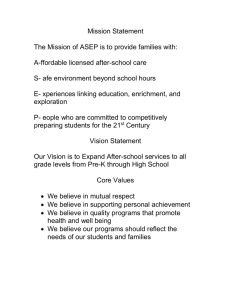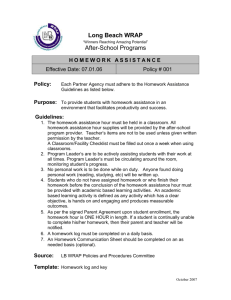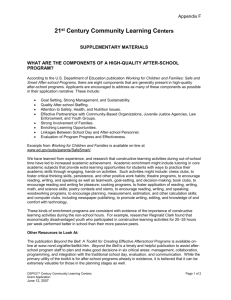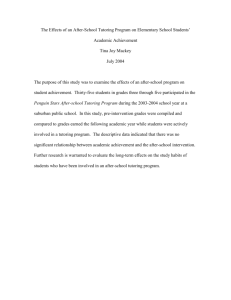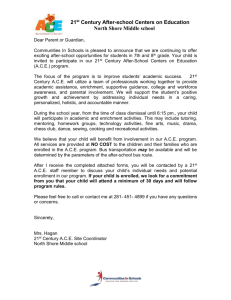At-Risk Students in After-School Programs: Outcomes and Recommendations
advertisement
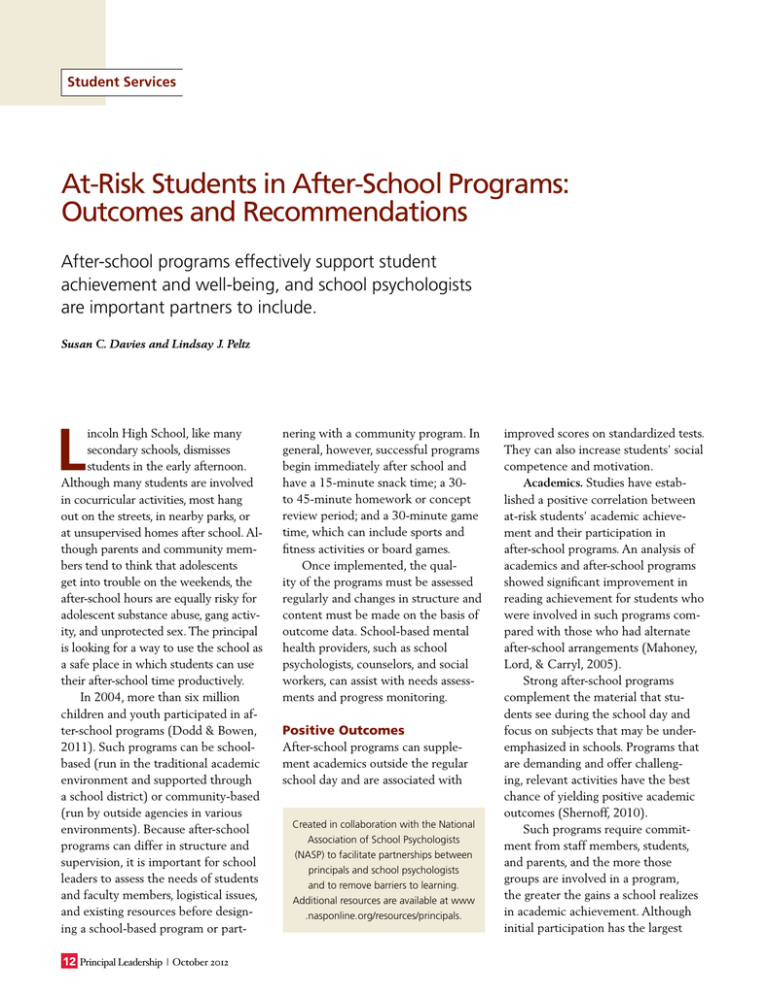
Student Services At-Risk Students in After-School Programs: Outcomes and Recommendations After-school programs effectively support student achievement and well-being, and school psychologists are important partners to include. Susan C. Davies and Lindsay J. Peltz L incoln High School, like many secondary schools, dismisses students in the early afternoon. Although many students are involved in cocurricular activities, most hang out on the streets, in nearby parks, or at unsupervised homes after school. Although parents and community members tend to think that adolescents get into trouble on the weekends, the after-school hours are equally risky for adolescent substance abuse, gang activity, and unprotected sex. The principal is looking for a way to use the school as a safe place in which students can use their after-school time productively. In 2004, more than six million children and youth participated in after-school programs (Dodd & Bowen, 2011). Such programs can be schoolbased (run in the traditional academic environment and supported through a school district) or community-based (run by outside agencies in various environments). Because after-school programs can differ in structure and supervision, it is important for school leaders to assess the needs of students and faculty members, logistical issues, and existing resources before designing a school-based program or part12 Principal Leadership | October 2012 nering with a community program. In general, however, successful programs begin immediately after school and have a 15-minute snack time; a 30to 45-minute homework or concept review period; and a 30-minute game time, which can include sports and fitness activities or board games. Once implemented, the quality of the programs must be assessed regularly and changes in structure and content must be made on the basis of outcome data. School-based ­mental health providers, such as school psychologists, counselors, and social workers, can assist with needs assessments and progress monitoring. Positive Outcomes After-school programs can supplement academics outside the regular school day and are associated with Created in collaboration with the National Association of School Psychologists (NASP) to facilitate partnerships between principals and school psychologists and to remove barriers to learning. Additional resources are available at www .nasponline.org/resources/principals. improved scores on standardized tests. They can also increase students’ social competence and motivation. Academics. Studies have established a positive correlation between at-risk students’ academic achievement and their participation in after-school programs. An analysis of academics and after-school programs showed significant improvement in reading achievement for students who were involved in such programs compared with those who had alternate after-school arrangements (Mahoney, Lord, & Carryl, 2005). Strong after-school programs complement the material that students see during the school day and focus on subjects that may be underemphasized in schools. Programs that are demanding and offer challenging, relevant activities have the best chance of yielding positive academic outcomes (Shernoff, 2010). Such programs require commitment from staff members, students, and parents, and the more those groups are involved in a program, the greater the gains a school realizes in academic achievement. Although initial participation has the largest impact, increasing the frequency of attendance also improves academic performance (Jenner & Jenner, 2007). Just as important is the relationship between students and their tutors; when students feel that their tutors care, academic achievement improves (Rothman & Henderson, 2011). Standardized testing. The US Department of Education is giving waivers from the original NCLB requirements to many states. In those states, demonstrating student progress toward competence is a valid outcome measure. After-school programs can facilitate this progress because the typical student who participates in such programs achieves a learning gain of one and one-third months over a counterpart who does not participate (Jenner & Jenner, 2007). This translates to meaningful academic achievement and a closing of the achievement gap for participants. Social competence. Dodd and Bowen (2011) estimated that 12 million youth in the United States will need assistance to avoid negative social and economic factors associated with at-risk environments. Students spend 75% of their waking hours outside of school, and lack of supervision during that time has negative consequences for them and for society. After-school programs can provide both the structure and positive reinforcement that students need so that they can learn prosocial values and behaviors and can be a venue for adults to model socially acceptable behaviors in real-life situations. Afterschool programs give adolescents the chance to enhance communication skills, learn to work and play effectively with others, and perform in public (Daud & Carruthers, 2008). Many of the elements of after-school programs contribute to positive peer relationships and create a family-like environment. Motivation and confidence. Students who are at risk tend to have low expectations for their success on novel and challenging tasks; they also are not motivated to pursue such tasks. But students involved in after-school programs feel more committed to academics and are more optimistic about their futures because they know that if they invest their time in hard work, they will see results. Students also have active roles in program decisions, carry out leadership roles, and serve others, all of which promote a sense of belonging and value. Stronger commitment to academics leads to improvement on homework and class work, ultimately resulting in better grades in school (Daud & Carruthers, 2008). Students in after-school programs have a variety of opportunities to succeed, learn, and be challenged, so their confidence in academics as well as in social situations grows. After-school programs give students opportunities to develop self-worth, feelings of accomplishment, and optimism about the future. Students in after-school programs have a variety of opportunities to succeed, learn, and be challenged, so their confidence in academics as well as in social situations grows. October 2012 | Principal Leadership 13 Student Services Establishing an After-School Program Although community-based after-school programs can connect with students in different ways than schoolbased programs can, school-based programs have a greater impact on student achievement because they have a closer collaboration with the school district and use common curricula. 14 Principal Leadership | October 2012 School-Based Versus Community-Based Although community-based afterschool programs can connect with students in different ways than school-based programs can, schoolbased programs have a greater impact on student achievement because they have a closer collaboration with the school district and use common curricula. Teachers often “have little direct contact with the families of their students, with their neighborhoods, or community traditions” (Lee & Hawkins, 2008, p. 53), leading to a lack of understanding of students’ lives outside of school. School-based programs that are staffed by teachers can help mitigate that problem and strengthen the role of schools as community centers. School-based programs can receive federal funding through grants or Title 1 funding. Federal funding provides money that can be used to pay college-educated tutors; because the tutors work in the schools, they can form effective relationships with teachers and use them as resources. School-based tutors can also monitor and encourage students to attend school. Further, research has shown that students who participate in more formal after-school programs that are housed in the students’ schools outperform students who participate in other programs on math and reading measures (Baker, Rieg, & Clendaniel, 2009). School administrators can help their schools successfully partner with existing community-based programs by sharing their schools’ core curricula, referring students, and facilitating a direct line of communication between teachers and program staff members. Administrators can encourage teachers to send the program tutors information about participating students’ current levels of performance, areas in which academic help is needed, and upcoming tests and projects. Overcoming Challenges Even successful programs face many challenges. Despite their many benefits, after-school programs tend to come and go because of a lack of funding (David, 2011). Programs may be further strained because of students’ behavioral issues or a breakdown in communication between service providers, parents, and students. Further, if the program has a large number of students, service providers may not be able to give each one individual attention. For their part, students can become burned out on the program and may misbehave. Participant responsiveness has significant implications for the ultimate success of after-school programs: if students are not invested in the program, they will not put forth the effort required to produce positive results, which in turn reflects poorly on the program as a whole. There must be a strong connection between students, teachers, administrators, and community organizations for programs to be sustainable. Because lack of funding is one of the major barriers to program implementation, school administrators Implementing a Successful After-School Program n Identify a program coordinator who will be responsible for the recruitment, training, and credential review of tutors. That coordinator assigns tutors to schools, trains and provides support to supervising teachers, copies materials, and writes year-end reports. n Select two supervising teachers within each building to serve as liaisons between classroom teachers and tutors. n Train tutors and mentors. Successful programs have welltrained staff members and activities that focus on skill objectives, active learning, and personal or social skills. n Set specific program goals and rules. Successful coordinators set ground rules, praise students for meeting expectations, ensure a consistent structure, and deal with rules that are broken in a firm but fair way. n Provide a means for collaboration with community agencies and families. should help districts apply for grant money. It is beneficial for administrators to stay in contact with local businesses and community leaders who donate money to organizations within the community. Often those businesses offer annual grants that can help offset the cost of running after-school programs, including the cost of supplies and snacks. School administrators can also keep an eye on websites that report on funding resources, such as CD Publications (www.cdpublications.com). Districts that have a high proportion of academically disadvantaged students can accept Title 1 funds, which can be used for any student within the district, including those in after-school programs. Because Title 1 money is allocated to n Combine academics, sports, and arts to maintain student interest. n Provide favorable adult-to-student ratios that ensure ­individualized support. n Provide proper facilities and equipment, predictable environments, opportunities for self-expression, sharing of feelings and thoughts, and time for unstructured play and fun. n Include progress monitoring for ongoing evaluation of student outcomes and to assess components of the program, such as effectiveness, accountability, and need for change. To address participants’ changing needs, solicit feedback and measure students’ perceptions of the program. The school psychologist’s knowledge and skills related to intervention efficacy, progress monitoring, and program evaluation can be helpful with this. districts by the government, schools must document how funds are spent. Conclusion The US Department of Education (2010) repeatedly emphasizes the importance of supporting programs that redesign and expand the school schedule, provide high-quality afterschool programs, and provide comprehensive supports to students. School administrators can effectively use their physical space, curriculum materials, and staff members to support the development and implementation of after-school programs. With school leaders establishing program logistics and setting a positive tone, all personnel can better see the value of keeping students after school. PL Because lack of funding is one of the major barriers to program implementation, school administrators should help districts apply for grant money. October 2012 | Principal Leadership 15 Student Services References n Baker, J. D., Rieg, S. A., & Clendaniel, T. (2009). An investigation of an after school math tutoring program: University tutors + elementary students = a successful partnership. Education, 127(2), 287–293. n Daud, R., & Carruthers, C. (2008). Outcome study of an after-school program for youth in a high-risk environment. Journal of Park and Recreation Administration, 26(2), 95–114. n David, J. L. (2011). After-school programs can pay off. Educational Leadership, 68(8), 84–85. Retrieved from www.ascd .org/publications/educational_leadership/ may11/vol68/num08/After-School_Programs_Can_Pay_Off.aspx n Dodd, A. T., & Bowen, L. M. (2011). 21st century community learning centers— improving the academic performance of at-risk students: A Bronx tale. Journal of Health and Human Services Administration, 34(1), 11–41. n Jenner, E., & Jenner, L. W. (2007). Results from a first-year evaluation of academic impacts of an after-school program for at-risk students. Journal of Education for Students Placed at Risk, 12(2), 213–237. n Lee, S. J., & Hawkins, M. R. (2008). “Family is here”: Learning in community-based after-school programs. Theory Into Practice, 47, 51–58. doi:10.1080/00405840701764763 n Mahoney, J. L., Lord, H., & Carryl, E. (2005). An ecological analysis of after-school program participation and the development of academic performance and motivational attributes for disadvantaged children. Child Development, 76(4), 811–825. n Rothman, T., & Henderson, M. (2011). Do school-based tutoring programs significantly improve student performance on standardized tests? Research in Middle Level Education Online, 34(6), 1–10. n Shernoff, D. (2010). Engagement in after-school programs as a predictor of social competence and academic performance. American Journal of Community Psychology, 45, 325–337. doi:10.1007/ s10464-010-9314-0 n US Department of Education. (2010). ESEA reauthorization: A blueprint for reform. Retrieved from www2.ed.gov/policy/elsec/ leg/blueprint/index.html 16 Principal Leadership | October 2012 Additional Resources Online Afterschool Alliance www.afterschoolalliance.org/ index.cfm After School Programs http://afterschoolprograms.com/ Afterschool Programs—From Vision to Reality www.thirteen.org/edonline/ concept2class/afterschool/index .html Afterschool Training T ­ oolkit www.sedl.org/afterschool/ toolkits Print Afterschool Matters: Creative Programs That Connect Youth Development and Student Achievement. S. Hill. 2007. Thousand Oaks, CA: Corwin Press. A Blueprint for Promoting Academic and Social Competence in After-School Programs. T. P. Gullotta, M. Bloom, C. F. Gullotta, & J. C. Messina. (Eds.). 2008. New York, NY: Springer. Building Effective Afterschool Programs. O. S. Fashola. 2001. Thousand Oaks, CA: Corwin Press. Susan C. Davies is an assistant professor and a coordinator of the school psychology program at the University of Dayton (OH). Lindsay J. Peltz is a graduate student in the school psychology program at the University of Dayton.
